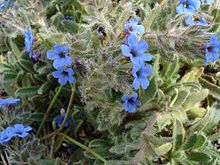Alkanna tinctoria
| Alkanet | |
|---|---|
 |
|
| Dyer's Bugloss | |
| Scientific classification | |
| Kingdom: | Plantae |
| (unranked): | Angiosperms |
| (unranked): | Eudicots |
| (unranked): | Asterids |
| Order: | (unplaced) |
| Family: | Boraginaceae |
| Genus: | Alkanna |
| Species: | A. tinctoria |
| Binomial name | |
|
Alkanna tinctoria (L.) Tausch |
|
Alkanna tinctoria, the dyer's alkanet or alkanet, is a herb in the borage family. Its main notability is its roots are used as a red dye. The plant is also known as dyers' bugloss, orchanet, Spanish bugloss or Languedoc bugloss. It is native in the Mediterranean region.
Alkanna tinctoria has a bright blue flower. The plant has a dark red root of blackish appearance externally but blue-red inside, with a whitish core. The root produces a fine red colouring material which has been used as a dye in the Mediterranean region since antiquity. The root as a dyestuff is soluble in alcohol, ether, and the oils, but is insoluble in water. It is used to give colour to wines and alcoholic tinctures, to vegetable oils, and to varnishes.
Powdered and mixed with oil, the alkanet root is used as a wood stain. When mixed into an oily environment it imparts a crimson color to the oil, which, when applied to a wood, moves the wood color towards dark-red-brown rosewood, and accentuates the grain of the wood.
Alkanet is traditionally used in Indian food under the name "Ratan Jot", and lends its red colour to some versions of the curry dish Rogan Josh. In Australia alkanet is approved for use as a food colouring, but in the European Union it is not.
It has been used as colorant for lipstick and rouge (cosmetics).
In alkali environments the alkanet dye has a blue color, with the color changing again to crimson on addition of an acid. The colour is red at pH 6.1, purple at 8.8 and blue at pH 10. Hence, it can be used to do alkali-acid litmus tests (but the usual litmus test paper does not use alkanet as the agent and its color change is closer to pH 7).
The colouring agent in Alkanna tinctoria root has been chemically isolated and named alkannin.
In English in the late medieval era, the name alkanet meant Alkanna tinctoria. In the centuries since then, the name has come to be used informally for some botanically related other plants; see Alkanet.
...
Wikipedia
